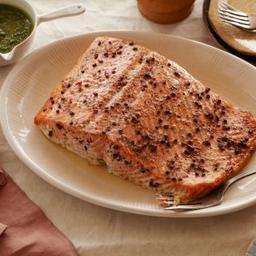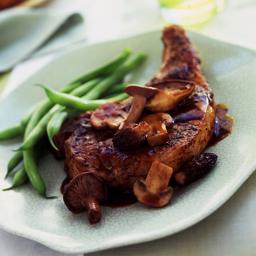
I’m not a true lexiphile but I get a little excited when I come across a word that has multiple meanings. Like “date” or “toast” or “season!” What a fun dinner conversation starter to list a few of those words with multiple meanings and then challenge everyone at the table to come up with as many multiple-meaning words as possible (no searching Google!). Words with more than two meanings get extra points…like “sage”.
“Sage” is one of those words with three meanings!
- To be a Sage, is to be someone who gives good advice, full of wisdom.
- Sage, the plant, is referenced as the herb of immortality, domestic virtue, health, and wisdom and adds a very distinctive flavor to recipes.
- And then of course, the color sage, is derived from the dusty green color of the plant.
 Sage has been cultivated for both culinary and medicinal purposes for centuries by the Greeks, Romans, Native Americans and Chinese. It has been promoted for many health conditions including sore throat, memory loss, diabetes and high cholesterol levels. it’s a good source of vitamin K, magnesium, zinc, and copper. It can be used fresh, dried, or as a tea. However, extended use of more than 4 cups of tea a day is not recommended as sage contains the compound, thujone, which, in rare cases, can cause seizures. Studies aren’t clear how much is too much so like many herbs, tinctures, oils etc on the market, make sure you check with your doctor for any use greater than general cooking.
Sage has been cultivated for both culinary and medicinal purposes for centuries by the Greeks, Romans, Native Americans and Chinese. It has been promoted for many health conditions including sore throat, memory loss, diabetes and high cholesterol levels. it’s a good source of vitamin K, magnesium, zinc, and copper. It can be used fresh, dried, or as a tea. However, extended use of more than 4 cups of tea a day is not recommended as sage contains the compound, thujone, which, in rare cases, can cause seizures. Studies aren’t clear how much is too much so like many herbs, tinctures, oils etc on the market, make sure you check with your doctor for any use greater than general cooking.
Here’s my sage advice…it’s time to cook with sage! The woodsy, piney, slightly peppery but fresh citrusy and minty aroma of sage reminds me of so many Fall-inspired recipes. If you’ve never cooked with sage (other than adding it to your turkey stuffing) let me give you some sage advice as to how and when to cook with sage to add extra special flavor to your dishes.
“Why should a man die who has sage in his garden? ~ Ancient Proverb
 Dried Sage:
Dried Sage:
Found in your spice aisle at the grocery store, dried sage or ground sage is concentrated and can have a bitter quality. Use in the beginning of a recipe so the flavor can mellow and infuse with the other ingredients. Dried sage is great in meat rubs, sauces, stuffings, breads and more. Note that DinnerTime recipes have been curated to give both fresh and dried options with the correct amount needed.
Fresh Sage:
Stronger in flavor than dried, in fact, the fresher the sage is the better, for the brightest taste. Most grocery stores will sell bunches of fresh sage, especially this time of year. I grow my own. It’s one of the easiest herbs to grow and it lasts through the winter. Check out these tips to easily grow your own sage plants. I add sage into most of my planters for the color and interest they offer. There are different varieties that are fun to grow as well as the more common green variety found for sale in the grocery store. Plant sage in your vegetable garden to repel bugs for carrots, cabbages, beans, tomatoes and broccoli. Like most herbs, the more you cut it, the better it grows.
 Start by stripping the leaves from the stems. Clean in cold water and pat-dry well. Depending upon the recipe, mince, chop or chiffonade the sage leaves. To chiffonade sage leaves, simply stack the leaves, roll the leaves together and then slice in thin strips, similar to julienne. This will keep the leaves from becoming bruised.
Start by stripping the leaves from the stems. Clean in cold water and pat-dry well. Depending upon the recipe, mince, chop or chiffonade the sage leaves. To chiffonade sage leaves, simply stack the leaves, roll the leaves together and then slice in thin strips, similar to julienne. This will keep the leaves from becoming bruised.- Store fresh sage in the refrigerator for up to one week.
- To freeze sage:
-
- Lay the leaves individually and spread out on a parchment-lined baking sheet and freeze. Once completely frozen, transfer to a zip-top bag, remove as much air as possible, seal, and store in the freezer. Let them thaw before using for best results.
- Chop fresh sage leaves and pack them into the molds of an ice cube tray. Fill the rest of the way with oil and freeze.
 Pan-fry fresh leaves in oil for a crispy topper for pasta, chicken, pork, roasted vegetables, potatoes…the list goes on. I learned how easy this was to do a couple of years ago. Start by coating the bottom of your pan with olive oil and heat until it shimmers. Lay the leaves in the pan single layer, not touching. Cook for approximately 30 seconds and remove with a slotted spoon to a paper towel. Sprinkle with salt for added flavor. I think these would also be great added to a charcuterie platter for a little something different!
Pan-fry fresh leaves in oil for a crispy topper for pasta, chicken, pork, roasted vegetables, potatoes…the list goes on. I learned how easy this was to do a couple of years ago. Start by coating the bottom of your pan with olive oil and heat until it shimmers. Lay the leaves in the pan single layer, not touching. Cook for approximately 30 seconds and remove with a slotted spoon to a paper towel. Sprinkle with salt for added flavor. I think these would also be great added to a charcuterie platter for a little something different!
Fun Fact: The ancient Greeks used sage to treat consumption, ulcer and snake bite!
Super Sage Recipes!
Search for more recipes in your DinnerTime Recipe Box.
Use the filter function (found on right of your DinnerTime Recipe Box search) to find desserts, main dish, side dishes etc.



